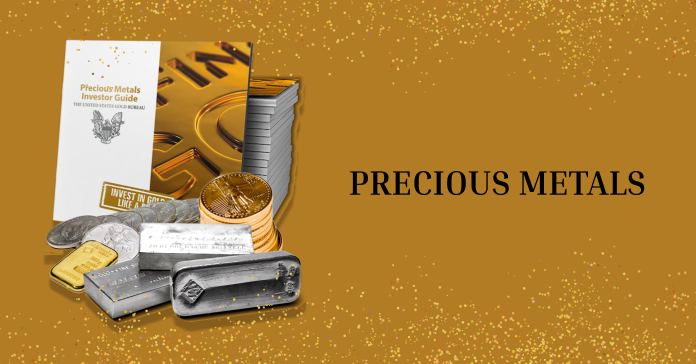Precious metals are special kinds of metal that are rare and highly valuable. They have unique qualities that make them highly prized. The most well-known precious metals are gold, silver, platinum, and palladium. These precious metals are not only beautiful to look at but also have important uses in various industries.
Access exclusive content on the moneymortal platform and stay informed with valuable updates.

Understanding What is Precious Metals
Understanding what is precious metals are can help you appreciate their value and importance.
Precious metals in better way have been important in the past because they were used to make coins or were the basis of money systems, like the gold standard. Today, people mainly buy precious metals as an investment.
Investors like to buy precious metals to diversify their investments and protect their money from inflation or economic troubles. Precious metals are also important for making products like jewelry and electronics.
The demand for precious metals is influenced by worries about the economy, fear of inflation, and the risk of war or political problems. Gold is the most popular precious metal for investments, followed by silver. Metals like iridium and palladium are also valuable because they are used in industries like electronics and chemical production.
Key takeaways
- Precious metals like gold, silver, platinum, and palladium are rare in nature and highly valued for their scarcity.
- These metals have a natural shine and can withstand corrosion, making them ideal for jewelry and other long-lasting items.
- Precious metals are used in various industries, including jewelry making, electronics, medicine, and even in certain environmental technologies.
- Many people invest in precious metals as a way to protect their wealth during economic uncertainty.
Top 10 Types of precious metals
These are the Top 10 precious metals that are valued for their unique properties and playing important role in various industries, from jewelry and electronics to automotive and aerospace applications. Understanding their uses and significance helps appreciate the diverse world of precious metals and their contributions to modern technologies and everyday life.
1. Gold
Description: Gold is a famous yellow metal, known and valued for thousands of years. It’s special because it doesn’t rust, can be easily shaped, and has a bright, attractive color.
Uses: Gold is commonly used to make jewelry and coins, in electronics for its excellent ability to conduct electricity, and as an investment to store wealth.
2. Silver
Description: Silver is a shiny white metal that’s more common than gold. It’s known for conducting electricity really well and reflecting light.
Uses: Silver is used in jewelry, silverware, electronics, photography (like in old film cameras), and industrial items like solar panels.
3. Platinum
Description: Platinum is a strong, silvery-white metal that doesn’t rust and is very durable. It’s rarer and often more valuable than gold.
Uses: Platinum is used in jewelry, car parts (like catalytic converters to reduce pollution), electrical components, and medical devices.
4. Palladium
Description: Palladium is a shiny, silvery-white metal known for its ability to speed up chemical reactions (catalytic properties). It’s part of the same metal group as platinum.
Uses: Palladium is mainly used in car catalytic converters, electronics, jewelry, and dental work.
5. Rhodium
Description: Rhodium is a rare and tough silvery-white metal, known for its resistance to rust and high melting point. It’s also part of the platinum group metals.
Uses: Rhodium is mainly used in car catalytic converters, in jewelry as a plating material, and in some electronics.
6. Iridium
Description: Iridium is a very dense, silvery-white metal and is the most rust-resistant element. It’s extremely rare in the Earth’s crust.
Uses: Iridium is used in spark plugs, containers for growing single crystals, and in special alloys that need to withstand extreme conditions.
7. Ruthenium
Description: Ruthenium is a hard, silvery-white metal that is part of the platinum group. It’s rare and doesn’t rust easily.
Uses: Ruthenium is used in electrical contacts, certain jewelry alloys, and as a catalyst in some chemical reactions.
8. Osmium
Description: Osmium is a very dense, bluish-silver metal and is the heaviest naturally occurring element. It’s toxic in pure form.
Uses: Osmium is used in alloys for fountain pen tips, surgical implants, and in some electronic applications.
9. Iridosmine
Description: Iridosmine is a natural alloy made of iridium and osmium. It’s usually found with platinum and other similar metals.
Uses: Iridosmine, like iridium and osmium, is used in specialty items like electrical contacts and as a catalyst.
10. Rhenium
Description: Rhenium is a rare, silvery-white metal with one of the highest melting points of any element.
Uses: Rhenium is used in high-temperature superalloys for jet engines, as a catalyst, and in electrical contacts.
Precious metals actively traded on market.

Gold, silver, platinum, and palladium are the most actively traded precious metals, They traded in physical forms, futures, options, and ETFs, allowing investors to speculate on their prices. Each metal is valued for its rarity, industrial use, and historical significance as a store of wealth.
Gold
Gold is a popular precious metal that has been traded for centuries. People can buy and sell gold in different ways. One way is by getting physical gold, like gold coins or bars, from banks or dealers. Another way is through something called futures and options. These are agreements where people can agree to buy or sell gold at a certain price on a specific date in the future. This helps investors make predictions about where the price of gold might go. There are also Gold Exchange-Traded Funds (ETFs), which are like investment funds that own gold. Investors can buy and sell shares of these funds on stock exchanges to get exposure to gold prices without owning the actual gold.
Silver
Silver is another precious metal that people trade. Like gold, you can buy and sell physical silver, such as silver coins or bars, from dealers. Silver futures and options work similarly to gold, where investors can speculate on the future price of silver. Silver ETFs are also available, allowing investors to invest in silver through exchange-traded funds that track the price of silver.
Platinum
Platinum is less common but still important in trading markets. People can buy and sell physical platinum from dealers or banks. Platinum futures and options are available for investors who want to make bets on future platinum prices. Additionally, there are Platinum ETFs that hold physical platinum, providing investors with exposure to platinum prices.
Palladium
Palladium is mainly used in industries like car manufacturing for catalytic converters. However, it is also traded in financial markets. People can buy and sell physical palladium in the form of bars or coins. Palladium futures and options allow investors to speculate on palladium prices without owning the metal. There are also Palladium ETFs that track the price of palladium, providing indirect investment exposure to this metal.
How you can Invest in Precious Metals
(Step-by-Step)
Investing in precious metals can be good option for those looking to diversify their investment portfolio. Here’s a step-by-step guide on how you can Invest in precious metals:
Learn about different precious metals like gold, silver, platinum, and palladium. Understand their uses, market trends, and how they are traded.
- Set Your Investment Goals: Determine why you want to invest in precious metals. Whether it’s for long-term wealth preservation or short-term profit, knowing your goals will help you make better investment decisions.
- Choose Your Metal: Decide which metal(s) you want to invest in based on your goals and market research. Gold is often seen as a safe haven, while silver can be more volatile but offer higher returns.
- Decide How to Invest: There are several ways to invest in precious metals:
- Physical Ownership: Buy coins, bars, or bullion from a reputable dealer. Consider storage and insurance costs.
- Exchange-Traded Funds (ETFs): Invest in ETFs that track metal prices. They are traded on stock exchanges and offer convenience and liquidity.
- Futures and Options: Trade contracts on precious metals through commodity exchanges. This is more complex and suitable for experienced investors.
- Mining Stocks: Invest in companies that mine precious metals. This option requires research into the mining industry.
- Open a Brokerage Account: If you’re investing in ETFs, futures, or options, you’ll need a brokerage account. Choose a reputable broker that offers the investment options you’re interested in.
- Make Your Investment: Purchase the metal or investment vehicle through your brokerage account. Pay attention to transaction fees and taxes.
- Monitor Your Investment: Keep track of the performance of your investment. Precious metals prices can be volatile, so be prepared for fluctuations.
- Consider Diversification: To reduce risk, consider diversifying your investments across different metals or investment vehicles.
- Review and Adjust Your Strategy: Regularly review your investment strategy and adjust it based on market conditions and your investment goals.
- Stay Informed: Stay updated on market trends, economic indicators, and geopolitical events that could impact precious metals prices.
Pros and Cons
| Pros | Cons |
|---|---|
| Rare and Valuable | Volatile Prices |
| Shiny and Durable | Environmental Impact from Mining |
| Versatile Applications | Storage and Security Concerns |
| Historical Significance | Potential for Counterfeiting |
| Investment Opportunities |
Conclusion
Precious metals like gold, silver, platinum, and palladium play important roles in our world. They are valued for their rarity, beauty, and usefulness in various industries. Investing in precious metals can offer diversification and a hedge against economic uncertainty. Whether you choose to own physical metal, invest in ETFs, or trade futures and options, it’s important to conduct thorough research and monitor market conditions. Remember, investing in precious metals carries risks, so always align your investment strategy with your financial goals and risk tolerance. Overall, understanding the unique properties and market dynamics of precious metals can help you make informed investment decisions and navigate the world of commodities effectively.
FAQ’s
1. Why are precious metals valuable?
Precious metals like gold, silver, platinum, and palladium are most valuable due to their rarity, unique physical properties, and historical significance. Their high luster, durability, and resistance to corrosion make them ideal for jewelry, coins, and decorative items. Additionally, they are valued as a store of wealth and are in demand for industrial uses in electronics, medicine, and automotive sectors.
2. How do I store physical precious metals safely?
Storing physical precious metals safely like gold, silver, platinum, or palladium requires careful consideration. Options for safe storage include using secure vault facilities, safety deposit boxes at banks, or insured storage services. It’s important to protect your investment from theft, damage, or loss by choosing a reputable storage solution.
3. Why are precious metals so expensive?
Precious metals like gold, silver, platinum, and palladium are so expensive due to their rarity, desirable properties like shine and durability, and their use in luxury items and advanced technologies. Their historical role as stores of wealth and market demand also drive their high prices, which can fluctuate with economic factors and global events.
